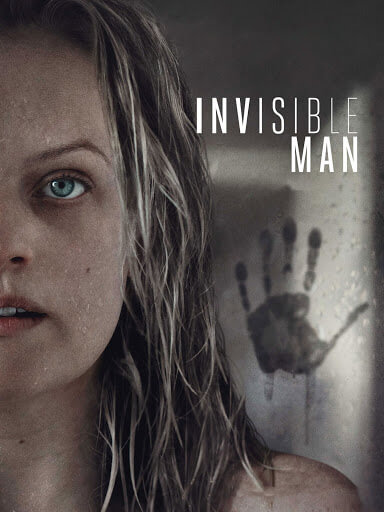Cecilia Kass (Elisabeth Moss) is forced to flee her abusive boyfriend, wealthy technology pioneer Adrian Griffin (Oliver Jackson-Cohen). Over the next two years, she lives in fear that Griffin will track her down — until she hears that her ex-boyfriend is now dead. But shortly afterwards, strange things begin to happen around Cecilia’s home, and she becomes convinced that even though nobody can see him, Griffin is alive and well.
The Invisible Man
Leigh Whannell (director, screenplay writer), Stefan Duscio (cinematographer), Andy Canny (editor)
Elisabeth Moss, Oliver Jackson-Cohen, Aldis Hodge, Storm Reid, Harriet Dyer, Michael Dorman (cast)
Universal / Blumhouse
February 27, 2020
Despite their timeless appeal, the monster stars of Universal’s 1930s, ’40s and ’50s horror films have had considerable trouble when it comes to being re-introduced for the twenty-first century. The 2017 version of The Mummy starring Tom Cruise was a flop, its failure putting paid to proposed universe-sharing tie-in films. There has been talk of a Creature from the Black Lagoon remake, but its thunder has been tidily swiped by Guillermo del Toro’s unofficial take on the Creature, The Shape of Water. Now, it is the turn of the Invisible Man to be re-imagined.
The Invisible Man series may be the most erratic of Universal’s classic monster sagas. The eerie 1933 original, adapted from H. G. Wells’ novel, was followed by sequels that varied wildly in tone, ranging from the horror-free comedy of The Invisible Woman to the wartime superheroics of Invisible Agent. This latest iteration, written and directed by Saw co-creator Leigh Whannell and produced in partnership with horror factory Blumhouse, offers a new take: notably, Wells is not even credited, even though the film borrows the name of his antagonist.
The key word for the 2020 Invisible Man is modern, the film hiding every trace of its Gothic-tinged origins beneath a gleaming new coat of paint. Gone is the bandage-swathed apparition of the 1933 film: this Griffin gains his invisibility from a high-tech suit, and would fit right in as a villain for a superhero film. Wells’ Invisible Man was a mad scientist who sought to control the world, an idea that was not yet a cliché in the nineteenth century; the film recognises that, in an era of Elon Musk going to court after calling a diver “pedo guy” on Twitter, mad scientists will come in strange new forms.
Most obviously, the film is relevant to the #MeToo era: the world that this wealthy and powerful Griffin seeks to control is the world of Cecilia. After playing with her grip on reality through the usual haunted-house routine of tugging on her bedclothes, the Invisible Man sabotages her portfolio for a job interview; next, he uses her email account to send an abusive message to her sister, and then hits the daughter of her housemate — and it is Cecilia who ends up taking the blame for each new move from this ultimate in gaslighting abusers. Progressing from Silicon Valley superstar to obsessive, intangible menace, the Invisible Man of 2020 is simultaneously Mark Zuckerberg and a lowly Facebook stalker.
Leigh Whannell’s direction is consistently intelligent. The film’s sophistication is on full show as early as the prologue, which depicts Cecilia’s escape from Griffin through a series of inventive shots: she awakes in bed and moves to reveal her partner’s hand on her side, the only part of his body that we see clearly. She then gets up and disables the security systems across the building, Griffin’s luxurious compound transformed through film language into a high-tech prison — silicon Gothic. Even the requisite jump scare is thoughtfully-composed, the camera cutting to the unexpected close-up of a metal dog bowl skidding toward the audience as Cecilia accidentally kicks it.
Also deserving of praise is Elisabeth Moss’s performance as Cecilia. Throughout the film the character is faced with intangible threats, not just in the obvious poltergeist-like business of being manhandled by Griffin, but also in the anxiety that plagues her even before the Invisible Man turns up. Whether she is twitching with agitation or glaring at an empty chair, Moss bridges the gap between the film’s more fanciful menace and the real-life emotions that underpin the fantasy.
Although the film deals with themes of stalking, gaslighting and emotional abuse, it should be stressed that The Invisible Man is concerned less with crafting a feminist manifesto and more with building a thrill ride. Leigh, true to his background in the gleefully intricate Saw films, comes up with plot twist after plot twist, so much so that any substantial discussion of the characters and their motivations will inevitably run into spoiler territory. Suffice to say that The Invisible Man manages to hold together right up to a bold conclusion: even as its setting multiplies in scale, the film retains its claustrophobic atmosphere. But then, this is merely a sign that the central concept of the Invisible Man has been handled correctly — his main menace as a monster, after all, is that we can rarely be sure how close or how far away he is.
Perhaps the way to most fully appreciate the film is to consider the easy paths that it could have taken, but instead avoided. There is a place for nostalgic camp about cackling men in sunglasses and bandages; there is also a place for shared-universe, teaser-after-the-credits franchise-building. But the 2020 Invisible Man shows that there is a place for another approach: an approach that involves digging down and finding out what made the Invisible Man scary in the first place, figuring out what can make him scary again in today’s context, and finally — through deft storytelling — making it all work.


